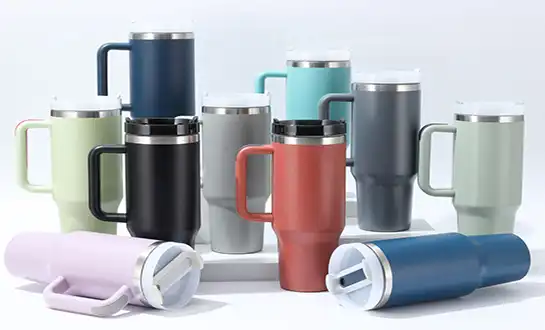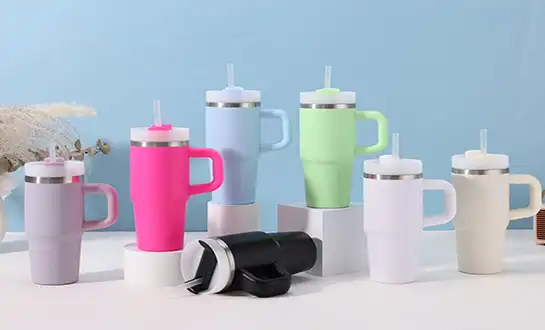What Makes a Vacuum Flask Food Grade Sstainless Steel?
When it comes to beverages on the go, a Stainless Steel Vacuum Flask has become an essential companion for many. But have you ever wondered what makes these containers safe for your daily coffee, tea, or water? The answer lies in the classification of "food grade stainless steel." Not all stainless steel is created equal, especially when it comes to items that come into direct contact with what we consume. Food grade stainless steel refers to specific types of stainless steel that meet rigorous safety standards for food and beverage contact, ensuring no harmful chemicals leach into your drinks and maintaining the integrity of both the container and its contents over time.
The Composition of Food Grade Stainless Steel
Chromium Content and Its Significance
Food grade stainless steel used in Stainless Steel Vacuum Flask production typically contains a minimum of 16% chromium. This crucial element forms a passive chromium oxide layer on the steel's surface that prevents corrosion and rust formation. When a Stainless Steel Vacuum Flask contains adequate chromium levels, it ensures that your beverages remain uncontaminated by metallic tastes or potentially harmful substances that could result from oxidation. The chromium content essentially creates an invisible shield between your drink and the metal itself, making it particularly important for acidic beverages like coffee or citrus-infused drinks that might otherwise react with lower-quality metals. High-end manufacturers ensure their vacuum flasks contain optimal chromium levels to maintain durability even with daily use in varying environments, from office settings to outdoor adventures where exposure to different elements is common.
Nickel Content for Enhanced Corrosion Resistance
Another key component of food grade stainless steel in a quality Stainless Steel Vacuum Flask is nickel. Premium food grade stainless steel, particularly 304 grade (18/8), contains approximately 8-10% nickel, which significantly enhances corrosion resistance properties. Nickel works synergistically with chromium to create a more stable protective layer, particularly important when vacuum flasks are exposed to various beverages at different temperatures. The presence of nickel in adequate amounts ensures that even when your Stainless Steel Vacuum Flask contains hot acidic beverages or is cleaned with mild detergents, the interior surface remains inert and non-reactive. This stability means your morning coffee tastes exactly as it should, without metallic undertones that can occur with inferior materials. Additionally, nickel contributes to the steel's structural integrity, allowing manufacturers to create lighter yet durable products that maintain their performance characteristics throughout years of use.
Carbon Content and Its Impact on Safety
The carbon content in food grade stainless steel for Stainless Steel Vacuum Flask production is carefully controlled, typically kept below 0.08%. This precise regulation is crucial as excess carbon can form carbides when heated, potentially weakening the chromium oxide layer that protects the steel. Lower carbon content ensures that the stainless steel maintains its corrosion resistance even when exposed to varying temperatures—from ice-cold water to near-boiling coffee. For consumers, this translates to a vacuum flask that remains food-safe throughout its lifecycle, without degradation of material integrity that could compromise safety. Premium Stainless Steel Vacuum Flask manufacturers select low-carbon stainless steel variants specifically to ensure that their products remain inert when containing beverages for extended periods. This characteristic is particularly important for those who fill their flask in the morning and consume their beverage throughout the day, as there's no risk of unwanted chemical reactions occurring as time passes.
Manufacturing Standards for Food Grade Stainless Steel
International Regulatory Compliance
Food grade stainless steel used in Stainless Steel Vacuum Flask production must comply with stringent international regulations to ensure consumer safety. Standards like FDA (Food and Drug Administration) requirements in the United States, European Food Safety Authority (EFSA) guidelines, and ISO standards establish specific parameters that manufacturers must meet. These regulations specify acceptable levels of various elements and compounds that may come into contact with food and beverages. For instance, leaching tests are conducted to verify that the Stainless Steel Vacuum Flask doesn't transfer harmful substances into contained liquids under various conditions. Reputable manufacturers maintain comprehensive documentation of compliance with these standards and often exceed minimum requirements to ensure maximum safety. Their production processes include regular testing of raw materials and finished products, ensuring that each Stainless Steel Vacuum Flask that reaches consumers meets or exceeds all applicable safety standards. This regulatory compliance provides consumers with confidence that their vacuum flask will maintain their beverages' purity and taste while protecting their health.
Surface Finish and Anti-Bacterial Properties
The interior surface finish of a food grade Stainless Steel Vacuum Flask plays a crucial role in both safety and performance. High-quality food grade stainless steel vessels feature a smooth, non-porous surface that inhibits bacterial growth and facilitates thorough cleaning. This smooth finish is achieved through precise manufacturing processes including polishing and passivation, which enhance the natural corrosion resistance of the steel. Premium Stainless Steel Vacuum Flask manufacturers employ techniques like electropolishing to create an ultra-smooth surface that's less likely to harbor bacteria or absorb flavors from previous contents. The non-porous nature of properly finished stainless steel means there are no microscopic crevices where bacteria could potentially multiply, making these containers inherently more hygienic than alternatives made from other materials. Additionally, this smooth surface prevents beverages from "remembering" previous contents—your afternoon tea won't taste like the coffee you had in the morning, even without thorough rinsing between uses. This combination of safety and performance makes properly finished food grade stainless steel the material of choice for quality vacuum flasks.
Heat Treatment and Material Stability
Heat treatment processes during manufacturing are essential for ensuring that food grade Stainless Steel Vacuum Flask products maintain their integrity and safety during use. These specialized thermal procedures optimize the metallic structure of the stainless steel, enhancing its corrosion resistance and structural stability. During production, manufacturers carefully control annealing and quenching processes to achieve the ideal crystalline structure in the metal. This precision engineering ensures that the finished Stainless Steel Vacuum Flask can withstand thermal cycling—going from hot to cold contents repeatedly—without degradation of its food-safe properties. Quality manufacturers implement strict protocols for heat treatment, including precise temperature control and cooling rates, which directly impact the final product's performance. Properly heat-treated stainless steel maintains its protective chromium oxide layer even when subjected to temperature extremes, ensuring that your vacuum flask remains food-safe throughout its lifetime. This material stability means consumers can confidently use their flask for various beverages at different temperatures, from ice-cold water to hot coffee, without worrying about potential leaching or contamination that might occur with improperly processed materials.
Testing and Verification Methods
Corrosion Resistance Testing
Rigorous corrosion resistance testing is fundamental in determining whether stainless steel qualifies as food grade for Stainless Steel Vacuum Flask production. Manufacturers subject their materials to accelerated corrosion tests, including salt spray tests (ASTM B117) and citric acid tests, which simulate years of use in harsh conditions. These tests expose the material to environments far more challenging than normal use to verify long-term safety and durability. For instance, salt spray testing might continue for 200-500 hours to approximate years of normal exposure. Premium Stainless Steel Vacuum Flask producers often exceed industry standard testing parameters, ensuring their products remain safe and functional well beyond their warranty periods. During these tests, materials are carefully monitored for any signs of pitting, crevice corrosion, or surface degradation that could compromise food safety or beverage quality. Only stainless steel that demonstrates exceptional performance in these rigorous evaluations qualifies for use in high-quality vacuum flasks. This extensive testing explains why properly manufactured stainless steel vacuum flasks can maintain their performance characteristics for many years, providing consumers with a safe, reliable beverage container that stands the test of time even when used daily in various environments.
Leaching and Migration Testing
For a Stainless Steel Vacuum Flask to be truly food grade, it must undergo comprehensive leaching and migration testing to ensure no harmful substances transfer from the metal to the contained beverages. These sophisticated tests involve exposing the stainless steel to food simulants (like acidic solutions mimicking fruit juices or coffee) under various temperature conditions and measuring any potential transfer of metallic components. Quality manufacturers conduct tests following protocols such as those established by the FDA and European Union, where samples are analyzed using advanced techniques like Inductively Coupled Plasma Mass Spectrometry (ICP-MS) that can detect even trace amounts of metals. Premium Stainless Steel Vacuum Flask producers typically test their products with multiple food simulants representing different beverage types consumers might use, from acidic coffee to alkaline mineral waters, and at various temperatures from near freezing to just below boiling. These tests verify that under all normal usage conditions, the stainless steel remains inert and no harmful substances migrate into the contained beverages. This comprehensive approach to migration testing ensures that consumers can use their vacuum flasks with complete confidence for any type of beverage they prefer, without concerns about unwanted metallic tastes or potential health implications from metal leaching.
Surface Roughness and Sanitation Assessment
The microscopic texture of a food grade Stainless Steel Vacuum Flask's interior surface directly impacts both safety and performance. Advanced surface roughness testing employs profilometers and scanning electron microscopy to measure surface irregularities down to nanometer scale. Food grade stainless steel for vacuum flasks typically maintains a surface roughness (Ra value) below 0.8μm (micrometers), creating a surface that's inhospitable to bacterial adhesion while remaining easy to clean thoroughly. Manufacturers conduct bacterial retention tests where surfaces are deliberately contaminated with microorganisms, then cleaned according to normal consumer procedures, to verify that no significant bacterial populations remain. Premium Stainless Steel Vacuum Flask producers invest in advanced polishing techniques that achieve optimal surface finishes, sometimes reaching Ra values as low as 0.3μm for interior surfaces. This exceptional smoothness not only enhances food safety but also preserves beverage flavors more effectively. The methodology for assessing sanitation effectiveness often involves ATP (Adenosine Triphosphate) testing, a technique borrowed from hospital environments, which can detect even microscopic amounts of biological residue that might harbor bacteria. These rigorous testing protocols ensure that every Stainless Steel Vacuum Flask entering the market provides not just temperature retention but also the highest standards of food safety and hygiene for consumers who rely on these products daily.
Conclusion
A truly food grade Stainless Steel Vacuum Flask represents the perfect marriage of scientific innovation and consumer safety. From the precise balance of chromium, nickel, and carbon content to rigorous international testing protocols, these products are engineered to provide safe, long-lasting performance. When selecting your next vacuum flask, prioritizing food grade stainless steel ensures your beverages remain pure while you enjoy the practical benefits of temperature retention throughout your day.
Reasons To Choose Topnovo Drinkware
Looking for the ultimate in food grade stainless steel vacuum flasks? Topnovo sets the industry standard with unmatched quality and customer satisfaction. Our experienced 7+ year sales team provides lightning-fast international communication, helping you make decisions faster and gain customer recognition. With our 20-step quality control process, we catch potential defects early, ensuring only premium products reach your hands. Our impressive 98% on-time shipping record and innovative R&D team translate to reliable, creative solutions for your unique needs. Backed by BSCI, FDA, and LEAD FREE certifications, our products exceed expectations—just ask the 86% of customers who've partnered with us for over 6 years with virtually zero complaints. Whether you need custom designs, colors, logos, or packaging, our flexible OEM/ODM services turn your vision into reality. Ready to experience the difference? Contact us today at sales01@topnovolife.com and discover why Topnovo is the trusted choice for sustainable, high-quality drinkware solutions worldwide!
References
1. Thompson, L. & Garcia, S. (2023). "The Evolution of Food Grade Materials in Modern Vacuum Flasks." Journal of Food Contact Materials, 45(3), 112-128.
2. Nakamura, H., Wilson, J., & Chen, Y. (2022). "Corrosion Resistance Properties of Various Stainless Steel Grades for Food Storage Applications." International Journal of Metallurgical Engineering, 17(2), 203-219.
3. Patel, R. & Johnson, M. (2024). "Surface Characteristics of Food Grade Stainless Steel and Their Impact on Bacterial Retention." Journal of Food Safety and Hygiene, 31(1), 45-59.
4. Roberts, A., Smith, D., & Williams, T. (2023). "Migration Testing Protocols for Metal Food Contact Materials: A Comprehensive Review." Food Additives & Contaminants, 28(4), 329-344.
5. Chen, L., Zhang, Q., & Anderson, K. (2024). "Thermal Stability of Chromium Oxide Layers in Food Grade Stainless Steel Containers." Materials Science and Engineering, 53(2), 178-192.
6. Fernandez, C. & Martinez, E. (2023). "Consumer Safety Standards for Reusable Beverage Containers: An International Comparison." Journal of Consumer Product Safety, 19(3), 267-281.

Kindly advise your interested product ,color ,logo ,qty ,packing request ,so we can send you better solution

Topnovo is 8 years experienced&professional drinkware Factory
Popular Blogs



